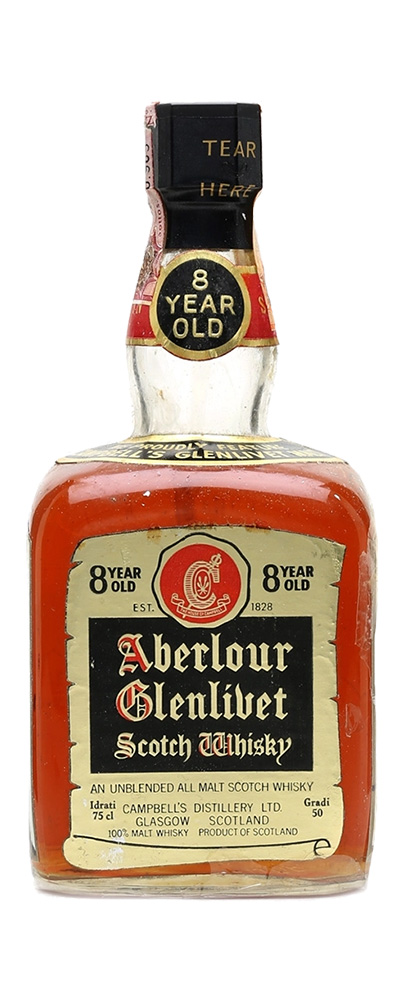The square or cube shaped bottles of Aberlour 8 Year Old have a great reputation for being relatively easy-to-get, nicely old-style whisky. From 1957 until 1985, most Aberlour was filled into this type of bottle, most importantly for the Italian market but also for France, Germany and the USA.
There’s definitely batch variation and it’s quite difficult to know which version you’re dealing with. Some of them have a distillation and/or bottling year on the front or neck label. Some of them say “8 Year Old”, others “8 Years Old”, “Over 8 Year Old” or “Over 8 Years Old”. Some of them have screw caps, others have a (small) cork stopper. Early bottlings say “Est. 1828” while later versions say “Est. 1845”. Some of them are bottled at 43%, others at 50%.
The one we’re trying today is supposedly one of the best versions. It says 8 Year Old, Gradi 50, Est. 1828 and has a small cork stopper.
When I tried it at a recent Fulldram tasting I had a lot of difficulty with the aromas. Despite its fame, I thought it was the worst whisky of the evening. Very dirty at first, lots of sulphury notes and cooked cabbage which I personally hate in sherried whisky. Aeration helped, but somehow the dirty side didn’t go away before the evening was over. I decided to pour most of my dram into a sample bottle and take it home, where I tried it again two weeks later. To my surprise, the nose had almost entirely cleared up.
Aberlour 8 yo (50%, OB early 1970’s, Italian market, cube shaped bottle, small cork stopper)
Nose: very different indeed. Still old-style, with some shoe polish and a good deal of rubbery hints, but it’s mostly nice sherry now. Slightly greasy, with quite some fruity sweetness, marzipan and a surprising level of vanilla. Brown sugar, leather. Hay. Then also some smoky notes in the background. After a while, it becomes frankly tropical, such a great twist.
Mouth: punchy and well-balanced. Sugar coated peanuts, smoked almonds, heather honey and dried fruits. A little mint. Vanilla cake. Then something in between liquorice and tar liqueur. Bitter oranges and herbal tea.
Finish: long, with more oak. Sweet and sour notes with a salty edge.
This shows that old whisky needs more time to assess, and some bottles need days after opening to show their best expression. Anyway I can see why this earned its fame, it’s a good example of old-style sherried whisky. Sometimes seen in auctions and LMdW is selling samples of a very similar bottling.
